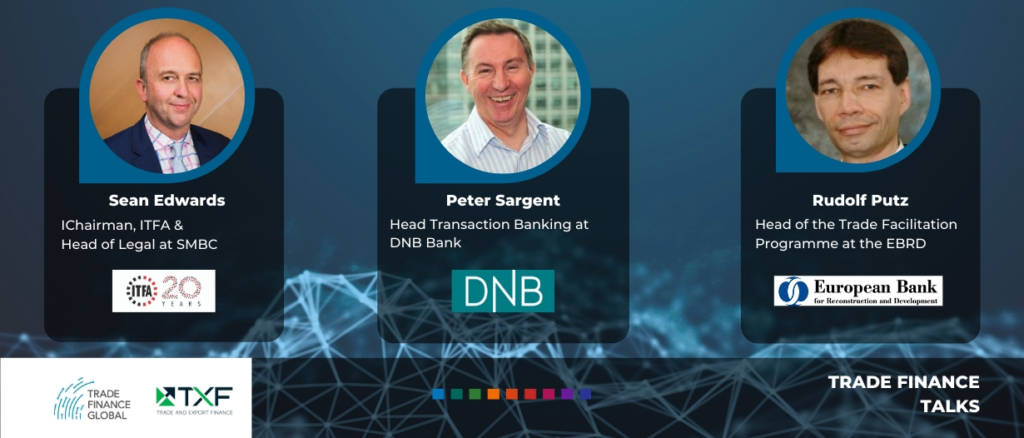TFG’s Deepesh Patel spoke to Matthew Beckett, Director of Insurance Placement at SMBC at Excred London. As trade risks and uncertainty abounds, we asked SMBC about how appetite has changed in 2019, and whether additional liquidity has impacted the distribution and origination business.
Featuring: Matthew Beckett, Director of Insurance Placement, SMBC
Host: Deepesh Patel, Editor, Trade Finance Global
Thank you for joining us on Trade Finance Talks TV. Who are you and what do you do?
You’re welcome Deepesh! So I’m Matthew Beckett, Director of Insurance Placement at SMBC, here in EMEA, where I oversee the credit risk insurance placement team for EMEA, but also with global oversight. I’ve been at SMBC for eight years and have 10+ years experience of being a credit risk insurance buyer.
Why do insurers work with trade financiers?
So why do insurers work with trade finance in the industry?
Trade finance has always been part of an insurer’s product pallet in terms of political and credit risks, and also they’re following their clients. We’ve worked with insurance for a good number of years, and trade finance is embedded within the institution. We’re originating business in areas of the world where we can provide access / new markets for insurers, whilst also allowing insurers to compliment their existing books of business. We know insurers like diversity – no doubt they’ll be ‘heavy’ in some areas, and perhaps our book helps provide some diversity, whether it’s by product type or by country.

What are the current challenges and opportunities within the trade credit insurance space?
I think we’ve actually gone through quite a stable 2019. With respect to challenges, there are more people competing in this market – that goes for insurers as it does banks. It’s not only banks who are looking to finance those [trade] flows, as there are competing, alternative pools of liquidity too. But in terms of a credit risk insurance context, I think the challenges arise from how this business can be worked through over the longer term – the underlying is quite short term in nature and is quite and labour intensive. How we can how can we scale the business to make it more efficient? Creating efficiencies may create more appetite and therefore additional capacity may come from carriers who perhaps traditionally haven’t looked at trade finance, for the very reasons that it’s perhaps too short term in nature.

Credit and political risk insurance – 2019 in review
Have you seen any changes given the current geopolitical macroeconomic events?
I think insurers actually remain pretty committed to the class business. And you could argue that the commodity cycle this year has actually been quite flat. So we’re not looking at 2015-16 for example (e.g. oil and Nigeria), where there was a distinct change in appetite – that goes for lenders, as it does insurers. Insurers in the main seem committed to the business flows we are originating. But we never know what is around the corner. The proof of the product and the proof of the relationship is how we can continue to transact through those dips in the cycles, very much as we have attempted to do in the in the years gone by.
From a distribution perspective, have there been any changes given that we’ve seen a number of non bank lenders come onto the scene? And how does this have any impact on the trade credit insurance?
Whether it’s had an impact on the credit risk insurance market, I’m not sure. I think for us, any additional liquidity on a distribution basis is kind of complimentary, instead of it being seen as competition or a substitute In terms of origination, then obviously there is a challenge, but then again that additional liquidity is perhaps looking at risks that we as a bank may not take. For us credit insurance is a central point to our strategy for origination & distribution on a trade finance basis, as it is for other asset classes within the business and it goes without saying that we will continue to distribute on an unfunded basis. It is part of the model we employ.

2020 predictions for trade credit insurance
And what market developments and I think I’m going to push a bit on the technology here are you looking at or predicting for 2020?
I think any advances that drive better efficiency need to be embraced. We are seeing more digital platforms in the market – we have seen consortiums of insurers putting their expertise and capital together to provide more workable, quicker solution products for banks. We as a bank will need to embrace new solutions and new technology. I guess it’s very much a case of moving that mindset away from the single facultative risk, and looking towards more scalable solutions, more committed solutions – the proof will be in the pudding. Banks have been originating in this space for a good number of years. Do we need insurers to look at every LC on a single risk basis or do they follow the fortunes of the bank, working with the people who they have established relationships with? The consumption for the product is obviously there for the bank. But, ultimately, it still all depends on capacity being supplied by the insurance market. So let’s see – 2020 might well be the year for innovation and new solutions.




























